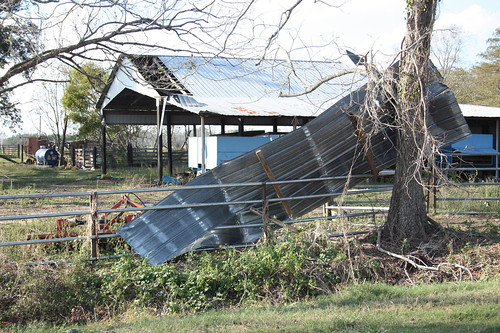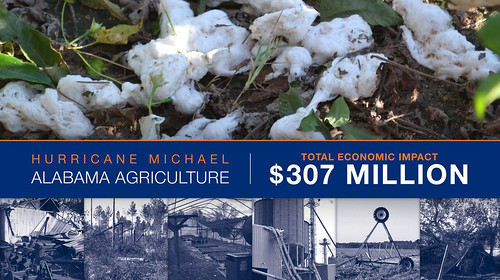Agriculture damage ripples through southeast Alabama economy
Article body
The impact of agriculture damage from Hurricane Michael is rippling through southeast Alabama’s regional economy. The associate director of the Alabama Cooperative Extension System said that total agriculture impacts top more than $300 million and could cost the region more than 2,500 jobs.
“Direct agricultural losses total $204 million alone,” said Paul Brown, Extension’s storm response leader. “But when you consider associated impacts on agricultural suppliers and the absence of household spending, the total damage done by Michael to Alabama’s agriculture industry and communities reaches $307 million.”
Cotton, which is grown on about 200,000 acres in the region, accounts for about 54 percent of the total damage or almost $163 million. Combined timber and pine straw losses reach $53 million, while livestock damages total more than $36 million.
Brown added that there is potential for loss of jobs as well.
“Our analysis shows it could mean as many as 2,500 jobs lost or affected in the Wiregrass economy,” he said of this southeast Alabama region known as the Wiregrass. “The job impact occurs through decreased agricultural activity in the region and the downstream effects through the supply chain and on main street.
“There is a direct connection to what happens on the farm and the broader industry and dollars spent in other Wiregrass businesses, such as grocery stores, restaurants and other retail outlets.”
Brown said that data analysis revealed what a devastating blow Michael dealt to agriculture and the regional economy.
Houston County, which suffered the worst effects, will take the hardest hit to its economy with total losses of more than $146 million.
“We estimate that the Houston County economy alone could lose more than 1,200 jobs.”
Geneva County was the second most affected county with total damages at more than $62 million and a possible job loss of 500. Henry County suffered losses of more than $45 million and potential job losses of more than 340.
Brown said that lost economic activity will also affect area governments.
“Local and county governments will see a loss in tax revenues from the storm,” he said. “That means they have less money to support government functions and infrastructure.”
Extension estimates that local, state and federal tax revenues in the region could decline by as much as $22.8 million.
The projected economic and job losses do not include possible disaster assistance that could be provided to the Wiregrass. Brown said that these losses would be tempered if disaster programs are provided to affected farmers. A positive trickle-down effect will lessen the losses to related industries, households and the community.
Alabama Extension will host a number of recovery meetings in the coming months to help farmers and producers move ahead. The first will be a livestock recovery meeting Nov. 14 from 6 to 8 p.m. The meeting, which will be at the Alabama Extension Houston County office, will discuss management options for feeding, grazing and fencing as well as updates on federal recovery assistance programs for livestock producers.
Find the complete report online at www.aces.edu.
Related Media
Media interested in this story can contact Communications Director Preston Sparks at (334) 844-9999 or preston.sparks@auburn.edu.
Auburn University is a nationally ranked land grant institution recognized for its commitment to world-class scholarship, interdisciplinary research with an elite, top-tier Carnegie R1 classification, life-changing outreach with Carnegie’s Community Engagement designation and an undergraduate education experience second to none. Auburn is home to more than 30,000 students, and its faculty and research partners collaborate to develop and deliver meaningful scholarship, science and technology-based advancements that meet pressing regional, national and global needs. Auburn’s commitment to active student engagement, professional success and public/private partnership drives a growing reputation for outreach and extension that delivers broad economic, health and societal impact.







